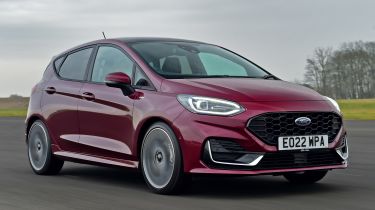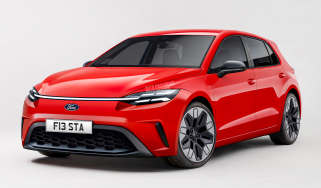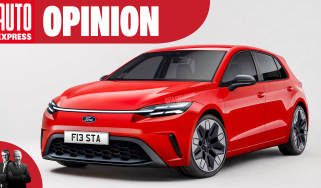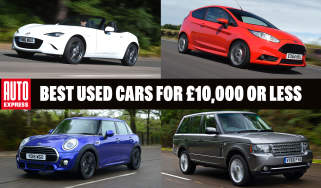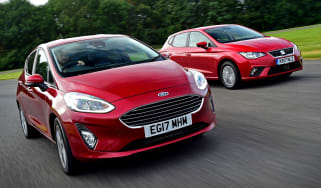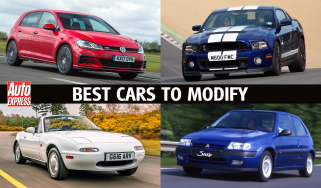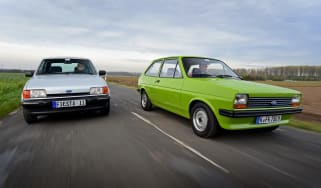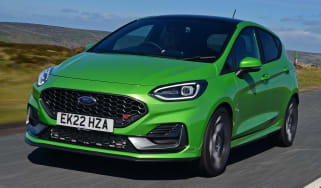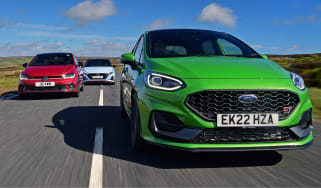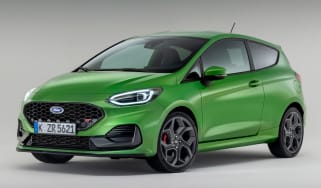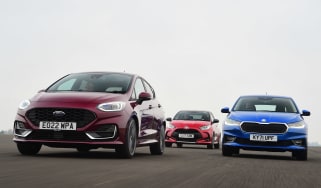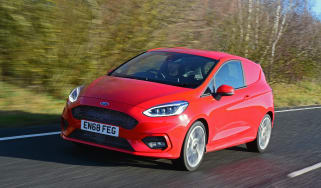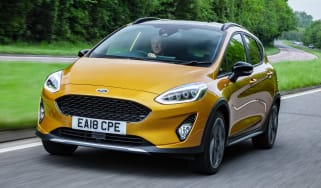Ford Fiesta (2017-2023) review
The last-ever Ford Fiesta supermini is good fun and remains a solid buy despite increasingly strong competition

The Ford Fiesta is a British motoring icon, and the latest model is one of the best 'real-world' cars around, because it ticks all of the rational boxes, but also manages to be great fun to drive.
Offering plenty of comfort, refinement and practicality, the Fiesta comes with plenty of standard kit, while the agile handling means it can easily put a smile on your face on the most mundane of journeys. With improvements made to cabin quality, infotainment and space, the current Ford Fiesta is the best it’s ever been.
About the Ford Fiesta
The latest generation of the Ford Fiesta was launched in 2017, and in many ways it was the arrival of this model which probably spurred the supermini market into action; the last one was so good, how could Ford go wrong with the follow-up?
As a result, brand-new versions of the SEAT Ibiza, Volkswagen Polo, Citroen C3, Kia Rio and Suzuki Swift arrived, updates were made to the Hyundai i20, Mazda 2 and Renault Clio, while big incentives were placed on models like the Vauxhall Corsa, Skoda Fabia and Peugeot 208 to help them stay attractive to buyers. It all means that buyers looking for a supermini have never had so much choice.
Used - available now

2024 BMW
i4
40,386 milesAutomaticElectric
Cash £32,456
2023 Audi
e-tron
73,065 milesAutomaticElectric
Cash £15,561
2023 Audi
e-tron
31,518 milesAutomaticElectric
Cash £21,843
2022 Volvo
XC40
36,922 milesAutomaticPetrol1.5L
Cash £23,024That's especially true of the Fiesta range itself. Ford has realigned the Fiesta model line-up to ensure there’s something to suit everyone. There’s eight models on offer, from the entry-level Trend through to the sportier ST-Line versions, and the hardcore Ford Fiesta ST to consider for those possibly thinking of the odd track day experience.
A facelift in 2022 brought in some styling tweaks, with Ford introducing its new family face which will feature on all upcoming models. There's a larger, more angular grille, with the blue oval badge now sitting within it, rather than at the top. The bonnet has also been redesigned, the nose of the car raised and new LED headlights fitted.
The sportier ST-Line models add a more aggressive front bumper, with a gloss black honeycomb mesh grille, and the higher-riding Fiesta Active now features vertical grille bars, plastic body cladding and silver accents at the front. New wheel designs are available across the range and updated on-board tech and extra safety kit is included, too. However, Ford has taken the decision to only offer a downgraded version of its Sync infotainment system for the Fiesta (prior to production ceasing in mid-2023), which means all models feature Sync 2.5 instead of the 3 version.
The Fiesta is now offered as a five-door model only, with the three-door variant no longer available on the price list. In terms of engines, there are three petrols available. The 1.1 Ti-VCT is the base unit, and delivers 74bhp. The 1.0 EcoBoost three-cylinder turbo petrol is the staple of the range, and it comes in 99bhp and 123bhp versions (the 153bhp model has been discontinued), with the more powerful engine using mild-hybrid technology to help improve fuel economy and CO2 emissions.
The sporty ST-3 uses a punchy 1.5T EcoBoost engine with 197bhp, while the frugal 1.5 TDCi oil burner was removed from the Fiesta range in 2020.
All cars use a six-speed manual transmission (with the exception of the 1.1L Ti-VCT five-speed manual), while the 123bhp petrol version is offered with the option of a seven-speed DCT auto 'box.
The Fiesta range also includes the Fiesta Active with its raised ride height and off-road styling for people who want an SUV, but like the compact dimensions of a supermini.
How much does the Ford Fiesta Cost?
There is, though, the inevitable downside, and with prices starting at more than £19,000 it’s not as affordable as it once was. If you want to specify additional luxury kit you’ll certainly pay for it: around £24,000 is needed to bag a 99bhp model in ST-Line X trim, while Ford wants around £27,000 for the racy ST-3 model.
Engines, performance and drive
With the Fiesta, Ford has proved yet again that small, cheap cars can be brilliant fun. The Fiesta might be new, but it will retain its reputation for being fun to drive as it’s better than ever through a series of bends.
Lighter steering in this new model means it’s easier to drive, especially in town, but that doesn’t take away from the driving experience on faster roads. There’s enough weight that you can feel the resistance coming through as you turn into a corner, and the feedback through the wheel means you can place the car on the road with ease. The grippy front-end helps too, as you can throw it in to corners even at high speed without fear of pushing wide.
A throttle lift or touch of braking will tighten the Fiesta’s line, and it’s rewarding to play with the little Ford’s chassis. Body control is very good, and bumps mid-corner don’t upset the balance - but what’s really amazing is that the car combines this agility with an impressively comfortable and composed ride. ST-Line models make things even more composed and fun with only a slight impact on ride quality.
The ride is good even on rutted roads here in Britain, partly because the Fiesta is so light - even the heaviest version is only a touch over 1,200kg. That helps it in so many areas: handling, ride, performance and even economy. Ford’s engineering magic means that even though the Fiesta is around 200kg heavier than the new Suzuki Swift, it feels almost as light on its feet.
The driving position is fantastic, as it feels sporty without being hard to get in and out of, and the steering wheel is just the right size to feel natural as well. The six-speed manual gear change isn’t quite as slick as the one in a Mazda 2, nor as light as the one in the new SEAT Ibiza, but it’s still really easy and fun to switch gears. These things also mean the Fiesta will be enjoyable to drive every day, not just when you find a great road.
Ford has also introduced mild-hybrid tech to the Fiesta range. The 48V system is available on the 1.0-litre 123bhp and (now discontinued) 153bhp petrol engines and helps to increase fuel economy, reduce emissions, while also providing a useful boost in torque.
A six-speed manual transmission is standard for all cars, with the exception of the 1.1L Ti-VCT five-speed manual, and the 123bhp petrol version which is offered with a seven-speed PowerShift auto 'box.
0-62mph acceleration and top speed
Our pick of the engine range is the 1.0-litre EcoBoost three-cylinder petrol engine. It’s been around for a little while now, but remains a top choice because it mixes so many great attributes: it’s punchy, economical and really fun to use all at the same time. It’s quiet as well, matching its rivals for refinement on the move - but without losing the characterful thrum of the three-cylinder engine.
It’s available with 99bhp or 123bhp and all are great options, but make sure you don’t overlook the lowest-powered version in the hunt for more performance. The turbocharger means it’s strong enough in the mid-range, and the 1.0-litre triple’s willingness to rev means it’s great fun to hustle along as well. More powerful versions are - unsurprisingly - more expensive, but the mid-spec variants offer enough pace for most needs.
The 99bhp EcoBoost takes 10.8s to go from 0-62mph, which goes down to 9.4s for the 123bhp engine, while if you track down a used 153bhp version (which is no longer available on the price list) you'll see a 8.9s sprint time. The 1.5T EcoBoost powers the ST-badged cars from 0-62mph in 6.5 seconds, with a 143mph maximum.
The base 1.1-litre three-cylinder petrol with 74bhp and a five-speed manual transmission is considerably slower at 14.7 seconds and doesn’t really offer much in the way of economy savings or improved emissions over the EcoBoost units. It would certainly be a peculiar choice when buyers could look towards the more modern alternatives in the range.
MPG, CO2 and running costs
Part of the magic of cars in the supermini class is that they can be fun to drive, more so than some much more expensive cars, without being pricey to run. The new Ford Fiesta is no exception to that rule, and its range of small-capacity petrol, hybrid and diesel engines are very frugal.
It’s not just about fuel economy, as purchase price and even the cost of fuel plays a big part in how cheap a car is to run. The petrol 1.0-litre EcoBoost with 99bhp provides a good overall package, however, returning up to 51.4mpg and emitting 125g/km of CO2.
The 123bhp manual version is able to return 56.5mpg on the combined cycle, while emitting just 114g/km of CO2. The extra power of the 153bhp hybrid (now removed from the price list) brings hardly any penalty to overall efficiency, with 56.5mpg and 113g/km.
For buyers wanting more miles from a tank of fuel, it might make sense to track down a used diesel model, as it returned the highest mpg figures of the range. The 84bhp 1.5-litre TDCi was the ultimate choice for economy, thanks to figures of 65.7mpg and 112g/km of CO2.
Insurance groups
Entry-level Fiesta Trend cars with the 74bhp 1.1-litre petrol are the cheapest to insure, sitting in insurance group 4E. The 99bhp EcoBoost model in Titanium trim, sits in group 10E - that should make it very affordable for most drivers to insure. However, the 197bhp ST-3 model incurs a higher premiums being in group 28E.
Our Car Tax Checker tool lets you check your tax status and renewal date in seconds. Check your VED car tax now...
Depreciation
Experts tell us that after three years and an average of 36,000 miles, a Ford Fiesta will hold on to around 49 per cent of its value, which is pretty good for such a popular car in the UK. The ST-3 model fares slightly better, retaining 52 per cent over the same period, while the Fiesta Active versions average around 48 per cent over the same three-year period.
To get an accurate valuation on a specific model check out our free car valuation tool...
Interior, design and technology
The new Ford Fiesta isn’t exactly a design revolution over the previous model, and that’s partly because the car uses the same Ford ‘Global B’ platform as before. That means lots of the unseen parts are the same, keeping the proportions broadly similar to before - and, therefore, the design. A familiar trapezoidal grille remains on the front, plus there’s a set of swept-back headlights and a rising shoulder line just like before.
Still, at the back there is quite a change, as the larger, more horizontal taillights and new tailgate give the rear a different stance on the road. The car is longer and wider than before, which helps with interior space, but it also means the new Ford supermini does have a new shape, even though it takes more than a glance to realise.
The bigger change to the Fiesta’s design is on the inside, though. There are fewer hard, scratchy plastics in there, replaced with soft-touch materials and a newer, more modern layout. A large, tablet-style touchscreen sits on top of the dash, just like in the Citroen C3 and Hyundai i20, with the heater controls placed lower down. It means the Fiesta is a far cry from the previous version covered in buttons and switches, and it feels more upmarket as a result. The SEAT Ibiza still wins for material quality and simple design, though.
Ford has taken the decision to offer all Fiesta models with its Sync 2.5 infotainment system (previously Sync 3), which means integrated sat-nav is no longer included. Entry-level Trend now feature 15-inch steel wheels as standard, along with cruise control, air-conditioning, and an eight-inch touchscreen. The popular Titanium model adds rear parking sensors, keyless start and extra safety tech.
The top-spec Vignale trim has been discontinued, as has the option pack of the same name that was available with Titanium, ST-Line and Active models. Track down a second-hand model and you'll benefit from 17 or 18-inch alloy wheels, premium Sensico synthetic leather seats and a 12.3-inch digital driver's display.
Sat-nav, stereo and infotainment
We think it's a shame that Ford hasn’t upgraded the Fiesta with the same large 10-inch touchscreen that’s now offered in the Focus, because it could’ve been a game-changer. However, the Fiesta would have needed a wholesale redesign of its dashboard to fit it, which was probably unfeasible within the time and budget constraints of the facelifted model.
As mentioned above, the Fiesta now includes a downgraded version of Ford's Sync infotainment system which does without integrated sat-nav. Apple CarPlay and Android Auto are included, allowing you to access your smartphone’s functions quickly and easily.
Practicality, comfort and boot space
Although some rivals such as the Honda Jazz offer much more interior space than the Fiesta, the Ford is now on a par with its more well-rounded rivals such as the SEAT Ibiza and VW Polo.
The Fiesta isn’t just spacious - it’s practical in the sense that it’s easy to drive, and the driving position is excellent. It’s not just for the average person, though, as the amount of adjustment in the wheel and seat means taller and shorter drivers will be able to get comfortable.
Visibility is good, apart from the small rear window and thick C-pillars. Parking sensors or a rear-view camera are offered on all but the base Trend versions, which some will find very helpful.
Dimensions and size
The Ford Fiesta is 71mm longer and 12m wider than the previous model, and the wheelbase is 4mm longer as well which helps with legroom in the back. In total, it’s 4,040mm long, 1,735mm wide, 1,466mm high and has a wheelbase of 2,493mm.
That makes it a little thinner than a Nissan Micra, but it is longer and taller and has a longer wheelbase. However it’s only by a matter of millimetres and most cars in this class are pretty much the same size on the outside; it’s the inside that really sets each model apart.
Leg room, head room & passenger space
Ford says there’s an extra 16mm of legroom in the back of the new Fiesta, and it does feel a little bit more spacious than before. It’s not as cavernous as a Honda Jazz in the back, but there’s more than enough leg and headroom even for taller adults in the back seats. The seating position in the back is a little bit too upright for total comfort, but for the kind of journeys buyers will use it for that won’t be a problem.
In the front there’s lots of space and both driver and passenger will be able to get comfortable thanks to the amount of adjustment offered in the seats.
Boot space
The Ford Fiesta is now available with 311 litres of luggage space with the seats up, and 1,093 litres with the rear seats folded down - a little more competitive, but not by much, as most cars in this class have a boot of a similar size.
The boot opening is wider than before too, which makes getting big items in and out easier. The loading lip is still quite high up, which hinders sliding in long items.
Reliability and safety
The Ford Fiesta ranked 68th out of 75 cars in our 2021 Driver Power customer satisfaction survey, with the Blue Oval's iconic supermini moving up just one place to 67th overall in 2022's poll. With eight of the top ten places going to more spacious SUVs or crossover-style cars, along with models featuring all-electric or plug-in hybrid power in their lineups, it highlights the trend of buyers looking towards alternatives to the more traditional route of fossil-fuelled superminis and hatchbacks - something which has led to the Fiesta range being discontinued from mid-2023.
Those lining up a Fiesta purchase will be pleased to know that the range does include new hi-tech safety gear such as cross traffic alert, adaptive cruise control and autonomous braking. This extra kit helped the Fiesta achieve a full five-star rating from Euro NCAP, scoring 87 per cent for adult occupant safety and 84 per cent for child occupant protection.
The 2022 facelift added further safety tech, including Wrong Way Alert', which is a camera-based system that works with the car's sat-nav technology to warn the driver if they are travelling against oncoming traffic. Matrix LED headlights can be ordered as an optional extra for all models, with the exception of the entry-level Trend, while the new Rear Occupant Alert system helps the driver avoid leaving pets or children in the rear seats.
Warranty
As with all Ford cars in Britain, the Fiesta has a three-year or 60,000-mile warranty as standard. It covers anything the goes wrong with the car mechanically - and you get coverage for corrosion and paint defects as well.
Three years is an industry standard, so the Fiesta is competitive, but the Hyundai i20 and Toyota Yaris have five-year warranties as standard, and the Kia Rio has seven years.
Servicing
Servicing your Fiesta is pretty straightforward - it’s once a year and you can pay around £550 for maintenance over the first three years from Ford. There are dealers all over Britain and lots of experienced mechanics too, so finding somewhere nearby to do it won’t ever be a problem.
Used and nearly new
The Ford Fiesta was first launched back in 1976 and, 40 years later, it’s more popular than ever. It’s been through eight generations over the years, but each one has been a huge success with the Blue Oval baby regularly topping the UK new car sales charts.
One of the first Ford models to get front-wheel drive, the Fiesta has always aimed to deliver practicality and low running costs above all else. The very early cars are now considered classics, while latest models represent one of the best small car used buys thanks to their upmarket appearance and sparkling driving dynamics.
Ford Fiesta history
Ford Fiesta Mk7: 2017-2023
The latest Ford Fiesta is one of the best yet, combining its predecessor's style and driving sparkle with an upmarket interior that’s packed with kit. It’s also a fraction roomier inside, while as before there’s a choice of rakish three-door and versatile five-door layouts. The high performance ST tops the range, but there are also luxurious Vignale and tough-looking Active models. Most versions also get the firm’s excellent SYNC3 infotainment system. Read our full Ford Fiesta Mk8 buyer’s guide here.
Ford Fiesta Mk6: 2008-2017
Combining head-turning looks with brilliant driving dynamics, the Mk7 Fiesta is a truly desirable small car. There’s a choice of three and five-door bodystyles, with both providing decent space and versatility. You’re also spoiled when it comes to engines, with a wide array of efficient petrol and diesels, plus there’s the fiery ST hot hatch. All cars are well equipped, but Bluetooth was an option on early cars, so double check if it's fitted. Read our full Ford Fiesta Mk7 buyer’s guide here.
Ford Fiesta Mk5: 2002-2008
The first genuinely all-new Fiesta since 1989, the Mk6 was heavily influenced by the brand’s trademark late Nineties ‘New Edge Design’. With square-edged styling and upright stance it looked more mini-MPV than supermini. More grown-up to drive than previous versions, it had a quality look and feel that rivalled models such as the VW Polo. It’s still a practical and reliable used car option, with bargain basement prices making it a great choice for those looking to buy a small car on a shoestring budget. You can read our full Ford Fiesta Mk6 buyer’s guide here.
Older Ford Fiesta models
Making its debut back in 1978, the original Fiesta was Ford’s first mainstream model to combine front-wheel drive and a hatchback. It was also one of the first to jump on the junior hot hatch bandwagon with the XR2. It’s now considered a classic, but many have rusted away to nothing.
Essentially a heavy facelift of the first-generation car, the Mk2 debuted in 1984 with a more rounded look. It also featured a less utilitarian interior and the option of a diesel for the first time.
When the Mk3 arrived in 1989 it became the first Fiesta to get a five-door option, while it also featured big car features such as optional ABS brakes. Wild RS Turbo model packed 130bhp and was identified by its green bumper inserts.
In 1995 a heavily revised Mk4 appeared and used all of Ford’s chassis-tuning know-how from the first Mondeo to deliver class-leading ride and handling. It was also the first to get the brilliantly smooth and responsive 16 valve Zetec SE petrol engines that continued to be used right through to the Mk6. However, it’s ‘fish face’ styling wasn’t to all tastes.
